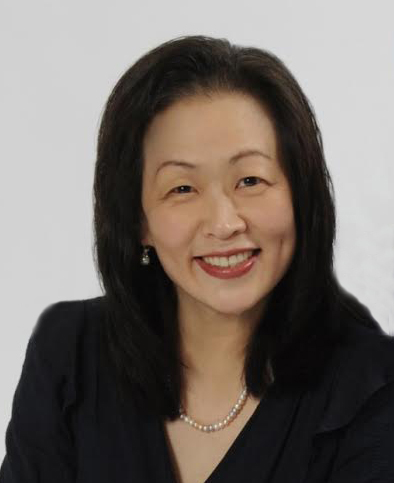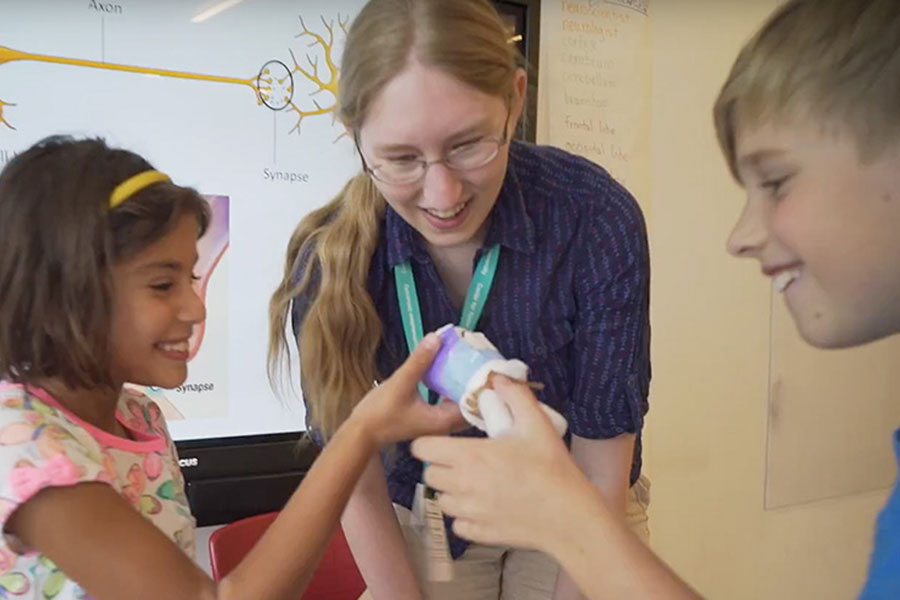CTD Welcomes Talent Development Scholar Susan J. Paik
By Beth Dirkes
Can genius be reverse engineered? Not exactly, but we can understand how talent is developed by taking a close look at the lives of individuals who have risen to the tops of their fields. Susan J. Paik, Ph.D., Center for Talent Development’s (CTD) visiting scholar, has done this work using biographical information.
 Dr. Paik is a professor at Claremont Graduate University in California where she studies talent development and educational productivity. In addition to studying more than 75 individuals by reviewing over 500 biographies and autobiographies, Paik has used a variety of quantitative and qualitative methods in her research. In her recent studies, she finds the biographical case study to be a “practical” approach because it allows for a close examination of the “lived experiences” of eminent individuals who may be deceased or otherwise out of reach. Paik and her research teams have studied top scientists, athletes, artists, and others who come from varied backgrounds. Among these, for instance, are Neil deGrasse Tyson, Sally Ride, Marie Curie, Michael Phelps, Serena Williams, Bill Gates, Maya Angelou, and Pablo Picasso. From her research, key patterns emerged from their life stories and they all had something in common, what she calls “productive giftedness”. Defined as “excellence, mastery, or expertise”, productive giftedness is derived from the Productive Giftedness Model [i], or PGM, a talent development model developed by Paik. In developing these concepts, she intentionally combined the terms “productive” and “giftedness” to respectfully reflect both “effort” and “ability”. While these terms seem contradictory, Paik believes that talent development requires both effort (productive) and ability (giftedness), as opposed to the traditional views of giftedness that relies solely on innate ability. The central premise behind PGM is that talent can and should be nurtured.
Dr. Paik is a professor at Claremont Graduate University in California where she studies talent development and educational productivity. In addition to studying more than 75 individuals by reviewing over 500 biographies and autobiographies, Paik has used a variety of quantitative and qualitative methods in her research. In her recent studies, she finds the biographical case study to be a “practical” approach because it allows for a close examination of the “lived experiences” of eminent individuals who may be deceased or otherwise out of reach. Paik and her research teams have studied top scientists, athletes, artists, and others who come from varied backgrounds. Among these, for instance, are Neil deGrasse Tyson, Sally Ride, Marie Curie, Michael Phelps, Serena Williams, Bill Gates, Maya Angelou, and Pablo Picasso. From her research, key patterns emerged from their life stories and they all had something in common, what she calls “productive giftedness”. Defined as “excellence, mastery, or expertise”, productive giftedness is derived from the Productive Giftedness Model [i], or PGM, a talent development model developed by Paik. In developing these concepts, she intentionally combined the terms “productive” and “giftedness” to respectfully reflect both “effort” and “ability”. While these terms seem contradictory, Paik believes that talent development requires both effort (productive) and ability (giftedness), as opposed to the traditional views of giftedness that relies solely on innate ability. The central premise behind PGM is that talent can and should be nurtured.
Acknowledging Context
The PGM identifies ten factors in talent development.[ii] These factors relate to individual aptitude, including ability, motivation, and development but do not stop there. Critical factors are also related to schooling (e.g., quality instruction, learning climates) and one’s non-school environment, including one’s peers, mentors and “home curriculum” (the structure and expectations set up by parents or other caregiving adults). Time usage in school and out of school can also make for large differences in how much students learn skills. It’s important to understand that many factors are “alterable”, while others are “contextual” and entirely beyond one’s control. For example, an aspiring writer, scientist or athlete can commit more time to reading, experimenting or practicing to hone their skills. Parents, teachers, or selective programs may even open doors for them. But historical, political, or demographic factors such as their race, gender or class can’t be changed by hard work or supportive parents. Yet, these contextual factors also will influence access to opportunities, support, and resources needed for their talent development. Marie Curie, for instance, who was the first female Nobel Prize recipient in Physics and Chemistry was initially denied a university education, speaking engagements, and other roles due to being a woman. Historically and politically, many women and other underserved groups were denied such access and opportunities.
Ability and Effort
Paik has noted a shift in talent development scholarship away from a focus on ability toward an emphasis on effort. This includes Duckworth’s work on grit [iii] and Dweck’s work on mindsets[iv]. But for Paik, these ideas don’t tell the whole story. “The problem with such approaches is that they’re oversimplified, because you can have a poor child, or even a rich child… but if they only have grit and mindset, it doesn’t matter because they will need all of the forms of support, opportunities and resources to move forward.”
High achievers who come from underserved and marginalized populations may need more resilience than their counterparts with more social or economic advantages, but that alone will not be enough. For instance, Neil deGrasse Tyson had to confront negative racial stereotypes repeatedly on his path to becoming an accomplished astrophysicist, but he also came from a supportive middle-class home, received topnotch training, and had Carl Sagan as a mentor.
A Model Partnership
Paik’s work has much in common with the research by Dr. Paula Olszewski-Kubilius, CTD’s director of 40 years, other CTD researchers’ work and with CTD’s programs. The goal of the research collaboration between CTD and Paik is mutual enrichment. As Paik put it, “I have always been an admirer of CTD which is why I’m here. And I am very much aware of the work done here. I love the mission…I completely support it. I believe in it. That’s why I wanted to come and spend my sabbatical as a visiting scholar here…I’ve been informed by their past research projects and…the programs…all of that is informative for the research projects that are emerging, including in my own work.”
The Talent Development Model which underlies CTD’s work, and Paik’s PGM are well-aligned. The overlap between the two models includes the importance of the role of parents and other stakeholders as well as supportive opportunities and resources early in a child’s life. The application of both models means putting in place meaningful ways to serve all students, especially traditionally underserved young people. Olszewski-Kubilius describes the talent development approach as offering more opportunity and direction to address the needs of a wider range of advanced learners, especially students from low-income backgrounds and culturally and linguistically diverse students.[v]
Still, there are also some notable but complementary differences between the models, specifically the PGM’s ten key factors and its emphasis on alterable and contextual factors. Paik’s five stages in talent development[vi] also addresses specific characteristics and pathways: Potential, Exposure, Cultivation, Mastery, & Eminence. In Paik’s view, the strength of her PGM model is that it’s comprehensive and systematic and can be generalized to any arena of work, place or time, and to people of any background. From her work, Paik has learned that “talent cannot be grown alone. It takes a village of support, a lot of opportunities and resources to nurture talent at every stage of development. Stakeholders in school and out of school need to find ways to work together to “alter” or optimize learning opportunities and resources to engage, challenge, and nurture potential into talent.” As she put it, “the reason why I do this research is because everybody has potential but not everybody develops it, and our goal is to figure out how to support the development of their potential.” That’s certainly a goal CTD and the students, parents, teachers, and schools it serves can get behind.
[i] Susan J Paik, “Nurturing talent, creativity, and productive giftedness: A new mastery model.” In Creatively gifted students are not like other gifted students: Research, theory and practice K.H. Kim, J.C. Kaufman, J. Bear, & B. Sriraman (Eds.), (2013): 101-119.
[ii] Susan J Paik, Charlina Gozali, & Kenya R Marshall-Harper, “Productive giftedness: A new mastery approach to understanding talent development” In R. F. Subotnik, S. G. Assouline, P. Olszewski-Kubilius, H. Stoeger, & A. Ziegler (Eds.), The Future of Research in Talent Development: Promising Trends, Evidence, and Implications of Innovative Scholarship for Policy and Practice. New Directions for Child and Adolescent Development 168, (2019):131–159.
[iii] Angela Duckworth, Grit: The Power of Passion and Perseverance (2016).
[iv] Carol S. Dweck, Mindset: The New Psychology of Success (2006)
[v] Paula Olszewski-Kubilius and Dana Thompson, “Talent Development as a Framework for Gifted Education” Gifted Child Today 38, no. 1 (2015): 49-59.
[vi] Susan J Paik, Lindsey Kunisaki, Vinh Q. Tran & Iraise Garcia, Developing talent into creative eminence: Understanding the productive giftedness of world class artists, Gifted and Talented International, (2021), DOI: 10.1080/15332276.2021.1961108

